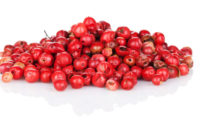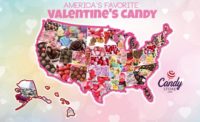While sweet flavor trends like matcha tea, blackcurrant and anise continue to gain traction, others are emerging, such as whiskey, citrus zest and saffron.
That’s according to the 2022 Kerry Taste Charts released by the Kerry Group, the world's leading taste and nutrition company.
Now more than a decade old, Kerry’s Taste Charts represent the company’s annual review of the food and beverage landscape utilizing sales performance, consumer trends, foodservice influences and internal culinary and mixology expertise to predict tastes for the coming year. In 2021, the Taste Charts correctly predicted that COVID-19 would lead to traditional tastes undergoing a popular resurgence as people sought comfort in their food and beverages.
“Consumers remain the driving force behind a lot of the food and beverage innovation that will shape the industry in 2022. There is no doubt that consumers will be seeking surprise and novelty in their food and drink choices,” explained Soumya Nair, global consumer research and insights director at Kerry. “We are also witnessing an even greater consumer desire for sustainability, but to ensure that what they eat and drink is not only tasty, but better for the people and better for the planet.”
Sweet flavor trends:
Mainstream sweet flavors
The Top 10 flavors for the past 5 years:
- Milk chocolate
- Vanilla
- Strawberry
- Peanut butter
- Caramel
- Cinnamon
- Coconut
- Blueberry
- Dark chocolate
Key sweet flavors
The next 15 flavors for the past 5 years
- Cherry
- Lemon
- Raspberry
- Fudge
- Banana
- Apple
- Honey
- Salted Caramel
- Orange
- Mint
- Cocoa
- Hazelnut
- Maple
- Cranberry
- Mango
Up & Coming
20 fastest growing flavors for the past 3 years:
- Sweet Treats
Snickerdoodle, Churro, Chocolate Chip Cookies, Birthday Cake, Key Lime Pie, Carrot Cake, Red Velvet Cake, Rocky Road, Crème Brulee, Cotton Candy and Baklava.
- Brown Sugar
- Blackcurrant
- Rosemary
- Café Latte
- Chili
- Butterscotch
- Lavender
- Blood Orange
- Wild Cherry
- Sugar Plum
- Matcha Tea
- Orange and Cream
- Cookies and Cream
- Black Rasberry
- Black Pepper
- Anise
- Passionfruit
- Chai (Tea)
- Brown Butter
Emerging
Top 20 fastest growing flavors last year:
- Kahlua
- Whiskey
- Citrus Zest
- Champagne
- Margarita
- Ube
- Cheddar Cheese
- Tangerine
- Sour Cherry
- Guava
- Rhubarb
- Acai
- Saffron
- Tahini
- Lychee
- Sage
- Cardamom
- Hibiscus
- Pandan
- Rose
For additional 2022 Kerry Taste Charts for salty snacks, savory and other segments, visit Kerry Group’s website.
The top six taste trends to watch for in 2022:
Kerry also identified six key trends that are set to shape the food and beverages in 2022, and nostalgia, indulgence, and surprise are set to drive flavor trends in the coming year.
While the underlying drivers that influence consumers associations with taste remain the same — comfort, health, and nostalgia — their insatiable appetite for something new means food and beverage businesses will be facing increased demand — and creative freedom — to innovate and bring new products to market.
1. Conventional Surprises
Challenging the norm, this is the consumers’ desire to seek comfort in food but with an added element of surprise from their classic favorites.
For instance, the global favorite chocolate milkshake would gain added appeal with surprise flavors such as lavender.
2. License to thrill
This calls to attention the deep desire of consumers to want to explore and satiate their sense of adventure with food. Where life has lacked spontaneity due to Covid-19, consumers are now turning to their plates/ or palette for the thrill.
For instance, the traditional hot chocolate would appear in different formats and applications, such as a hot chocolate cookie sandwich or a hot chocolate enrobed potato chip.
License to thrill also rings true for international flavors that consumers want to experience closer to home, or in their own kitchens, such as zaatar, Aleppo pepper, Sakura –Japanese cherry blossom.
3. Tasty, but healthy
Driven by consumers desire to be healthy, and with an increasing focus on probiotic health, gut health and immune support, consumers are looking for health-forward (beyond a health halo), food and beverages that make them feel like they are taking an active role in their future health.
But taste remains at the core of consumption desire and people now want the best of both worlds — sugar free, lower carb, plant-based, vegan and diet-specific foods like keto — to also be tasty and they are not willing to compromise on taste any longer.
When consumers want collagen and nootropics and adaptogens from their food and beverages that help them achieve their health goals they also want those same indulgent, nostalgic and comfort flavors that they so crave when it comes to taste.
Botanicals such as Sage, Rosemary, Lavender, and Citrus Blossoms are set to be very popular in combination with classic flavors, as consumers seek taste-forward flavors that also help them achieve certain functional health goals — in this case emotional wellness. Think beyond beverages, but across salty and sweet food alike across the globe.
4. Authentic memories
While many thought that they would never long for school lunches again, there is a desire to evoke childhood memories and traditions or long-lost moments from the past. Consumers want to be transported back in time, with the comfort and indulgence that comes from the authentic flavors and ingredients that tell these stories. Flavors like custard, breakfast cereal, sultana and fudge are on the rise in the sweet category as consumers return to old favorites.
5. Provenance with a conscience
More than 50 percent consumers focus on, and prioritize, sustainability in food and beverages.
Building on the traction seen previously, expect to see an increased focus on flavors and ingredients that have transparent origins, are sustainably sourced and are ethically processed.
These ingredients are gaining prominence as consumers begin to understand the subtle taste differences of regionally and seasonally derived products that impact their community, their environment, and the planet.
Consumers still want to enjoy chocolate and extracts like vanilla but want to know how they are sourced, where they are sourced from, and the community-aid provided in the process of sourcing.
6. Over-the top-indulgence
Comes from a pure place of crave-ability as consumers’ desire indulgence from everyday snacks and sweets, during socially-heightened occasions, or celebrating special moments.
This could be a double chocolate fudge brownie shake or an expensive cheesecake delivered home from their favorite Michelin star restaurant.
Flavors that invoke a deep sense of indulgence typically comes from chocolates, caramel, sweet forward flavors, but we also see that indulgence comes from craving meals ordered from favorite restaurant that they couldn’t visit mid-pandemic this year.





